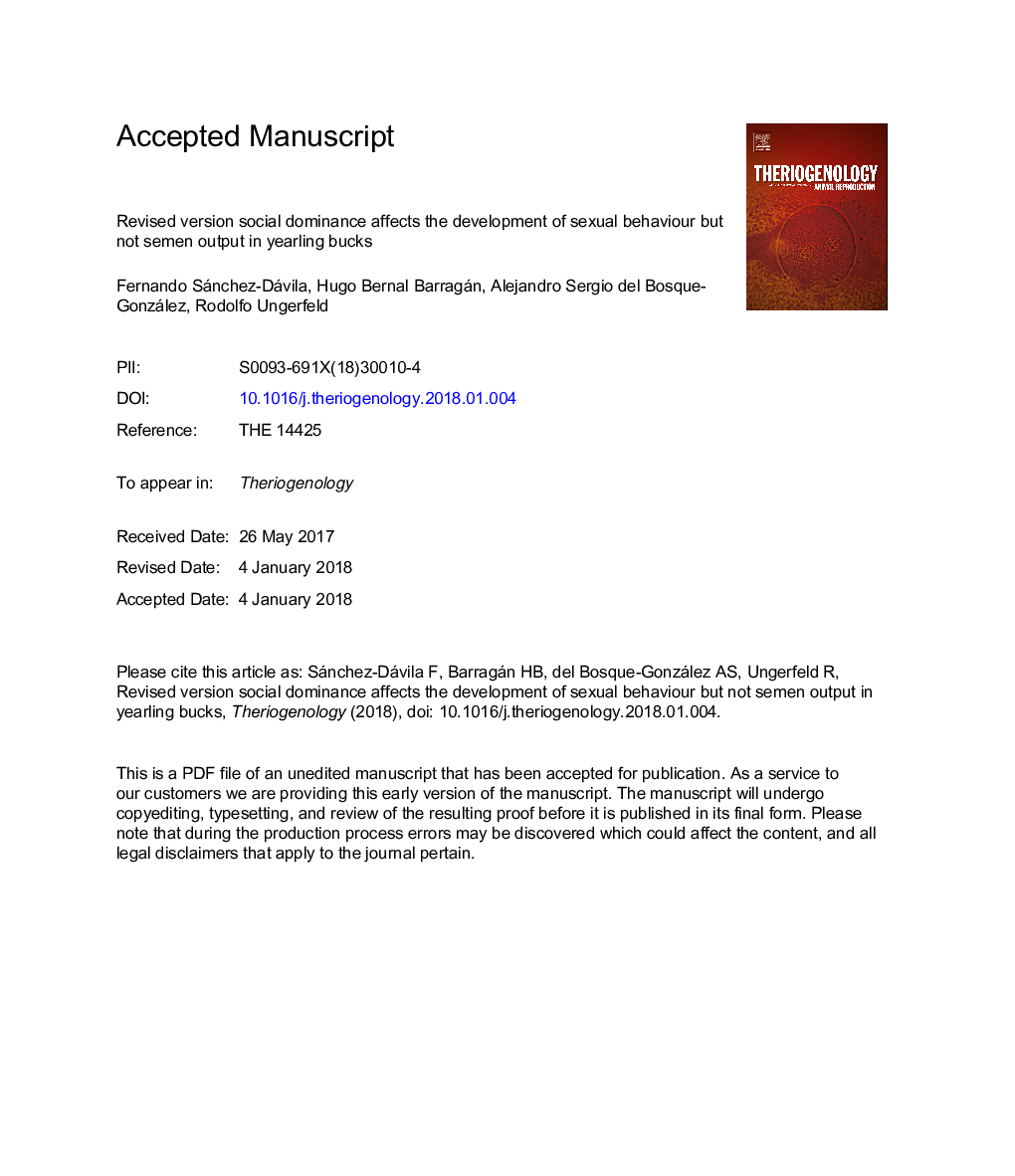| کد مقاله | کد نشریه | سال انتشار | مقاله انگلیسی | نسخه تمام متن |
|---|---|---|---|---|
| 8427485 | 1546059 | 2018 | 30 صفحه PDF | دانلود رایگان |
عنوان انگلیسی مقاله ISI
Social dominance affects the development of sexual behaviour but not semen output in yearling bucks
ترجمه فارسی عنوان
تسلط اجتماعی بر توسعه رفتار جنسی تاثیر می گذارد، اما خروجی اسپرم در سالمندان با درآمد سالانه تاثیر نمی گذارد
دانلود مقاله + سفارش ترجمه
دانلود مقاله ISI انگلیسی
رایگان برای ایرانیان
کلمات کلیدی
کورتیزول، کیفیت اسپرم، رفتار جنسی، سلسله مراتب اجتماعی، استرس اجتماعی، تستوسترون،
موضوعات مرتبط
علوم زیستی و بیوفناوری
علوم کشاورزی و بیولوژیک
علوم دامی و جانورشناسی
چکیده انگلیسی
Goats are polygynous seasonal mammals that establish dominant-subordinate relationships, especially in bucks. The aims of this study were to: 1) compare the reproductive development of dominant and subordinate young bucks allocated in dyads, and 2) determine if their previous dominant position affect their response to grouping. Twenty-four young bucks were allocated in dyads when they were 4 mo old, and the dominance position (DP) [dominant (DB) or subordinate buck (SB)] was determined with a test of competition for food. Body weight, scrotal circumference, semen quality and sexual behaviour toward an oestrous ewe were weekly determined during 8 weeks beginning when the bucks were 8â¯mo old. Body weight, scrotal circumference, and seminal parameters were not affected by DP. Dominant bucks tended to begin sexual courtship earlier than SB bucks (Pâ¯=â¯.09), but displayed less flehmen (Pâ¯=â¯.0008) and tended to display less ano-genital sniffings (Pâ¯=â¯.053). However, DB bucks displayed more lateral approaches (Pâ¯=â¯.019), attempted to mount, mounted, and mated the oestrous doe more times (Pâ¯<â¯.0001, Pâ¯=â¯.0002 and Pâ¯<â¯.0001, respectively) than SB bucks. In the 9th week, all the bucks were grouped, cortisol and testosterone serum concentrations were measured, and agonistic and sexual behaviour between bucks were recorded during the first day. Semen was collected and evaluated 4 and 9 days after grouping. Cortisol concentration increased (Pâ¯=â¯.037), but testosterone decreased (Pâ¯<â¯.0001), after grouping the animals, without differences according to their DP. The DB tended to display more lateral approaches toward other bucks than SB bucks (Pâ¯=â¯.06), but there were no effects of DP in any other behaviour. Sperm concentration and the total number of sperm in the ejaculate decreased after grouping (Pâ¯=â¯.01 and Pâ¯=â¯.009 respectively. In conclusion, in the conditions of this study, dominance relationships affected sexual behaviour but not body or testicular size or semen output in young bucks allocated in dyads. Dominant bucks were more effective displaying sexual consummatory behaviours. Grouping all the bucks together displayed a strong stress response that affected testosterone secretion and sperm output which was of similar magnitude in bucks that were dominant or subordinate individuals before.
ناشر
Database: Elsevier - ScienceDirect (ساینس دایرکت)
Journal: Theriogenology - Volume 110, 1 April 2018, Pages 168-174
Journal: Theriogenology - Volume 110, 1 April 2018, Pages 168-174
نویسندگان
Fernando Sánchez-Dávila, Hugo Bernal Barragán, Alejandro Sergio del Bosque-González, Rodolfo Ungerfeld,
